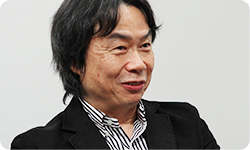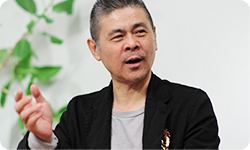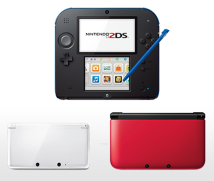4. ''Can You Make It Jump Out?''
Nintendo - and Miyamoto-san above all - has tried all this time to bring us the fun of 3D.
Yes. But that was a theme (Hiroshi) Yamauchi-san always focused on.
Oh, okay.
Whenever he had the chance, he would say, “What about 3D?”
And “Can you make it jump out?” (laughs)
Yamauchi-san liked Virtual Boy.
He liked it when things jump out.
(laughs)
Oh, I see… So 3D has been a theme for Yamauchi-san and Miyamoto-san all this time.
That’s right.
Yeah. But come to think of it, our efforts in 3D got sort of pushed aside after the release of the Nintendo DS and Wii systems, but during that time we did try to achieve 3D visuals at Shigureden.19 19Shigureden: An exhibition covering the Ogura Hyakunin Isshu (Ogura Anthology of 100 Poems by 100 Poets) that opened in the Arashiyama district of Kyoto in January 2006. Operated by the Ogura Hyakunin Isshu Cultural Foundation. Visitors experience the world of hyakunin isshu using a guide system called Shigureden Navi on a Nintendo DS system.
Shigureden is the hyakunin isshu (100 poems by 100 poets) theme park that Yamauchi-san made and Miyamoto-san produced.
Uh-huh, right.
When we were making Shigureden, Yamauchi-san expressed his earnest hope that we could make something “jump out.” (laughs)
(laughs)
Oh.
We got pretty far along with regard to the methodology, but didn’t have enough time to develop it and gave up. But we did get to do a lot of research with regard to the liquid crystal and other matters involved.

So you happened to learn about 3D.
When I hear that, I think Yamauchi-san has played a big role.
Very big.
If not, none of this - meaning the whole company - would be what it is.
No, it wouldn’t. For example, take the question of why the Nintendo DS system has two screens. That’s because Yamauchi-san was intensely interested in dual screens. He told us to make something with two screens, and because of that strong request, Miyamoto-san and I - sort of reasoning backwards - started pondering what kind of game activities would make use of two screens.
Uh-huh, uh-huh.
That led to the idea of using one screen as a Touch Screen. Without Yamauchi-san’s enthusiasm, Nintendo DS wouldn’t be in the form it is.
That enthusiasm is important. It shows a company’s individuality.
Yes, I think so.
It’s true.
These days, I’m always saying that when we get old we should be selfish. That’s because I think an organisation needs someone like Yamauchi-san.
I know what you mean. Rather than airing all opinions to draw a fair conclusion, saying, “This is what I like!” is what pulls people and a company along.

Right. The larger an organisation is, the more important it is to say, “I’ve decided this is what we’re going to focus on this time!” There are endless possibilities for what a company should do, so if someone doesn’t determine a policy, its power rapidly disperses. That’s why people like Miyamoto-san and I have to make decisions and say, “Let’s do this!”
That’s more about desire than correctness. Like, “Can you make it jump out?”
That’s right! (laughs) That's why even when Nintendo failed with Virtual Boy, the company stubbornly persisted, putting 3D circuits in Nintendo GameCube and making a Game Boy Advance system with a built in 3D LCD.
And as we were trying things out, one thing we decided was to make it glasses-free. We flat out decided that 3D should be enjoyed without using special glasses or goggles.
If it hadn’t been for the failure of the Virtual Boy system, so many of our people might not have said, “As long as special glasses are necessary, 3D is impossible.”
Oh, I see. I suppose not. Hmm. That’s interesting. (to be continued)
